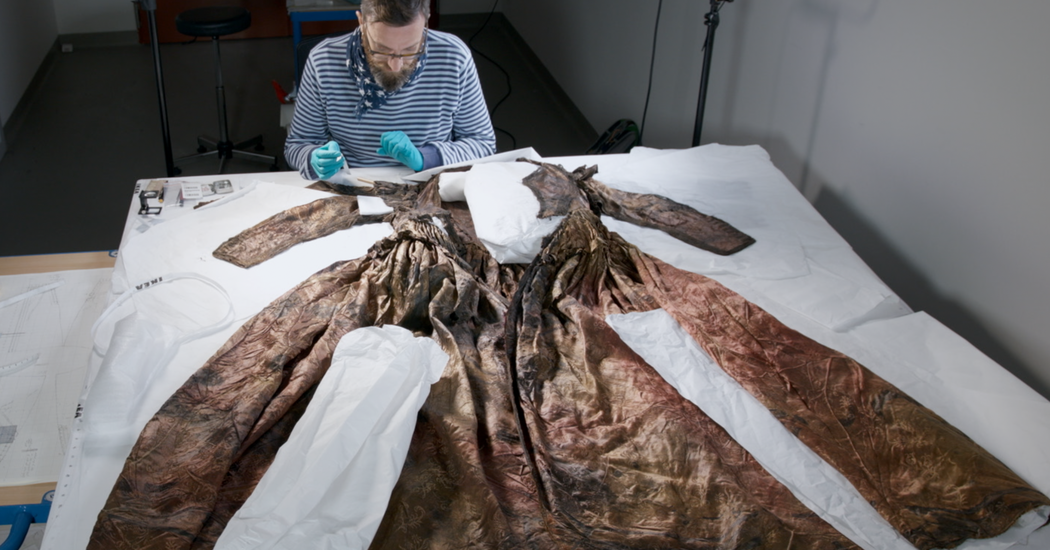The year is roughly 1650. A merchant ship — carrying goods, passengers and a highly expensive silk satin dress that will centuries later become a topic of fascination — sinks, like so many other ships at the time, in the North Sea, off the Dutch island of Texel.
Sand soon covered the shipwreck, which was largely forgotten until 2014, when Dutch amateur divers found the dress, almost perfectly preserved, and brought it to dry land. The divers also found a different, silver dress, book covers and what appeared to be 17th-century women’s toiletries, among other things.
The wrecked ship, known as the Palmwood because of the type of wood found in the remains, has since been the subject of a museum exhibit, as well as an upcoming multimedia project that includes a podcast, a television show and a digital reconstruction.
But despite the surge of interest, the mystery of the silk dress has not been solved. Who owned the clothes? Where was the ship going? And who was on board?
The answers are probably underwater.
The dresses and other objects are on display at Museum Kaap Skil on Texel, a Dutch island about 60 miles north of Amsterdam with fewer than 14,000 residents. The well-preserved silk dress has drawn thousands more museum visitors than is usual during the winter months since it went on display in November, said Corina Hordijk, the artistic director of this museum and three others on the island.
“The thought that this dress was on the bottom of the sea for centuries is insane,” Ms. Hordijk said. “The last person who touched it before this was probably the person who wore it.”
The dresses, probably made in about 1620, were about 30 years old by the time they went down with the ship. The silk dress had a wider waist and was probably for an older woman, researchers said. The silver dress may have been a wedding dress, which could mean that the two dresses had different owners, they added.
“These dresses were incredibly expensive,” said Arnold van Bruggen, the director of the upcoming television documentary on the topic. “These dresses would not have been seen outside of royal court circles.”
The clothing and objects also help round out our understanding of women from a time when history books mostly focus on male naval heroes, said Tjitske Mussche, the maker of the podcast “The Dress and the Shipwreck,” a companion piece to Mr. van Bruggen’s TV show. The silk dress brings the 17th-century woman into closer view, she said.
Mr. van Bruggen and Ms. Mussche said they had arrived at three plausible theories, based on their conversations with historians, scientists and others. All three point to the owner of the dress being a member of the upper classes, but other details haven’t been proven. One possibility is that the clothes belonged to a theater company that was fleeing England. A second, based on research by a historian at the Oxford, is that the clothes, as well as the other items, belonged to the deceased wife of an ambassador and were being taken back to England from Constantinople. A third possibility is that the objects belonged to a wealthy Eastern European family who were escaping the Thirty Years’ War.
Researchers believe the ship may have been a merchant vessel that also carried people and their luggage, Ms. Mussche said. There was a lot of naval traffic between England and Holland at the time, including people escaping the Puritan revolution in England, Mr. van Bruggen said.
Ms. Mussche said she hoped there would be more research into the wreck, as well as others. “It would put the whole idea of the maritime 17th century into a new perspective,” she said.
That’s up to the Dutch government.
Diving expeditions are timely and costly, said Thijs Coenen, a maritime archaeologist with the Netherlands’ Cultural Heritage Agency, and the agency only sends divers to the bottom of the sea for two months out of the year, because of bad weather conditions and a lack of funding. Digging out the entirety of the Palmwood wreck from the bottom of the sea would take years.
Another complication is making sure that museums and researchers have the ability to safely store and study the items that divers find in the wreck, Mr. Coenen said.
The agency has covered the Palmwood wreck with a type of mesh to protect it from erosion and other damage, which could preserve it for decades. There are multiple shipwrecks from the 17th century in the Netherlands, many of them not as well-preserved, and the government has to weigh where to send its divers. Mr. Coenen said he didn’t rule out the possibility that the agency’s divers would return to the Palmwood wreck at some point over the next few years. (In total, there are about 3,000 known shipwrecks in Dutch waters, Mr. Coenen said.)
One thing is clear: This particular wreck is extraordinary, and may contain many more historical gems.
Hans Dijker, one of the amateur divers who found the dress in 2014, at first wasn’t aware that he had found such a special item, and was even more unsure of what to do with a dress, of all things. For a while, Mr. Dijker said, “It just hung on a hanger in our clubhouse.”

Tinggalkan Balasan